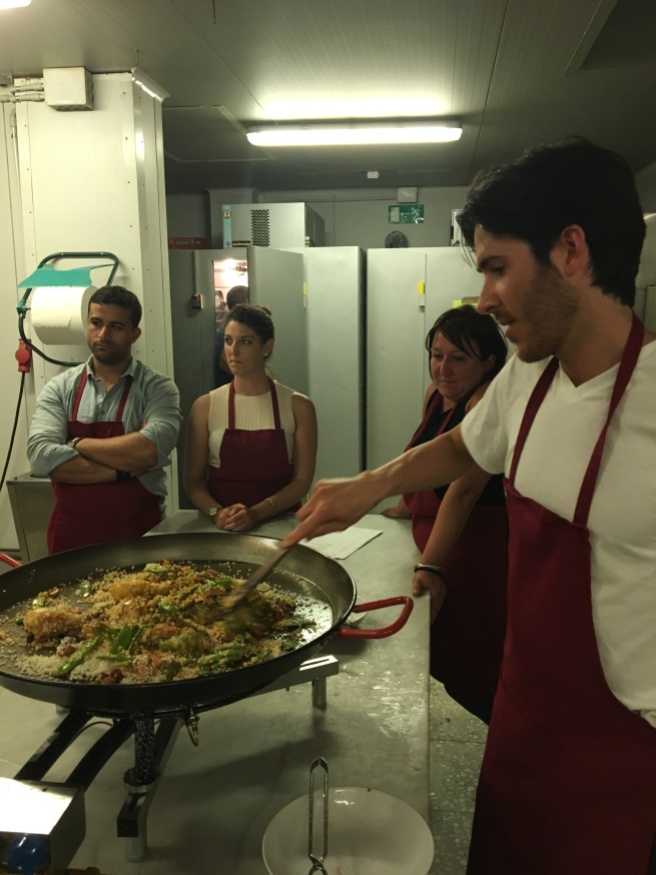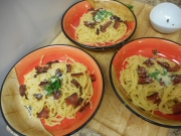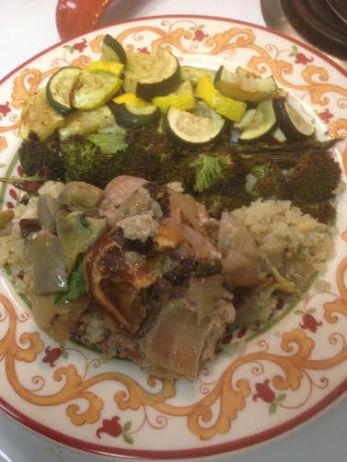As many of you may have seen if you follow me on social media, I was recently on holiday in Spain. I embarked on this Spanish adventure to see the beautiful and iconic sites, engage with the vibrant people and culture, and of course, I went to eat and drink A LOT. I enjoyed a truly unfathomable amount of sangria and indulged in Spain’s national dish, paella. Now, I will not recount every single meal I ate nor review every single restaurant that I dined in; if I did that, I would be on my way to publishing a travel guide. I will, however, share a wonderful experience I had; my Paella Cooking Class through Airbnb Experience.

I highly recommend Barcelona.
If you live under a rock and are unfamiliar with Airbnb, read about it here. For the rest of you who know Airbnb already, you might be surprised and delighted to learn that Airbnb now offers “Experiences” in which locals host an event, tour, or class of some kind that gives participants a taste of their city and community. Airbnb users visiting that city or community sign up and attend to join in the “experience” offered; it could be a hike through scenic hills followed by a picnic, a pub crawl, an art tour, or really anything that a host feels would be a good way to experience their homeland. The concept is unique and fantastic, offering travelers a chance to not only learn something new and/or do something fun under the guide of a local, but also the chance to meet up with other travelers! I think you should check it out.
Anyway, while I was in Barcelona, I noticed that Airbnb Experience was advertising a Paella Cooking Class. Upon further inspection, I learned that for just $30 I could attend this cooking class, instructed by a local cook, hosted in a professional kitchen, and learn to make sangria, paella, and a Catalan cream dessert, which I would then get to eat and enjoy. Sign me up and take my money! I was in.
The class was led by Eladi, a Catalonia-Spain native with a passion for cooking and drive to share traditional Spanish and Catalan cooking techniques with others. He believes in cooking with quality ingredients and infusing the food you cook with love and good energy; my kind of guy!

The class took place in the kitchen of a bakery which we were allowed to use for our cooking purposes. With it being a professional kitchen, we had plenty of space for our class (and bonus, the bakery happened to be a 1 minute walk from my Airbnb!) And so, under Eladi’s instruction, our group of nine Airbnb travelers gathered around a big center island in the kitchen and set out to learn!
Eladi taught us first to make the traditional, and dearly beloved, Spanish drink that we all know and love, Sangria. He gave us a little background on its origins and then divvied out tasks for a few of us to do: squeezing oranges, cutting apples, etc. I myself had never made Sangria and so I really enjoyed learning the basic measurements and techniques for making it because I would like to make and drink more Sangria on a normal basis (you know, for health reasons). Anyway, we mixed everything in a big pitcher and stored it away in the fridge to emulsify for the next couple of hours, with the promise of our being able to drink the sangria when it and dinner was ready!
See Eladi’s original recipe for traditional Sangria here: Sangria Recipe
Below, I have rewritten the recipe to be in the British-American recipe format and using American measurements.
Sangria
Ingredients:
- 4 cups red wine
- 1 large apple, large cubed
- 1 large orange, sliced
- 1 large orange, juiced
- 1 large lemon, sliced
- 1 large lemon juiced
- 2 sticks cinnamon
- ¼ cup sugar
- 2 cups soda water
- Ice
Directions:
Pour the wine in a pitcher. Add the juices of the orange and lemon. Add the cubes of apple, slices of orange and lemon, and the cinnamon sticks. Add the sugar and stir. Allow to chill for minimum 2 hours to maximum 24 hours. To serve, add ice and soda water, serve, and pour.
Pro-Tip: Sangria really should be made with Spanish wine and if you are in the States, Trader Joe’s has this good, inexpensive choice! See below!


Next, we moved onto making the Catalan Cream for dessert, a very popular and traditional dessert in Spain’s region of Catalonia. It is essentially a custard made from milk, sugar, egg yolks, cinnamon, and lemon which is chilled in individual dishes, topped with sugar, then torched to create a sugar-glass crust. Think of a cross between flan and crème Brule, flavored with lemon and cinnamon; that’s Catalan Cream. Similarly, Eladi asked for volunteers to execute tasks like beating egg yolks and sugar together and so on. I am not a huge dessert eater or creator, so I really enjoyed adding this dish to my repertoire!
See the original recipe here: Catalan Cream Recipe
Again, below I have rewritten the recipe to be in the British-American recipe format with American measurements.
Catalan Cream
Ingredients:
- 4 cups milk
- 2 cinnamon sticks
- Peel of 1 whole lemon
- 1 ½ tablespoons corn starch
- 8 egg yolks
- 1 cup sugar
Directions:
Place 3 cups of the milk, the cinnamon sticks, and the lemon peel in a small sauce pan and bring to a boil over medium heat. Once boil is reached, turn off the heat and allow flavors to infuse for 10-15 minutes. Discard the cinnamon sticks and lemon peel after this time.
Meanwhile, in a large bowl, beat the remaining 1 cup of milk, egg yolks, sugar, and starch until well mixed.
Add the egg mix to the sauce pan with the milk. Bring back to a boil over medium heat, continuing to whisk until the mixture starts to thicken, about 8 minutes. Turn off the heat and whisk 1 more minute.
Pour the mix into individual clay pots or ramekins and chill for 2-24 hours. When ready to serve, top each surface with an even layer of sugar, about a tablespoon, and using a blow torch, burn the sugar until a crust is formed. Serve and enjoy!

Finally, we embarked on cooking the main course, the highlight; traditional Spanish Paella! Here again, even with how big of a cook I am, I had never tried to cook paella, though I’d always wanted to. In this setting with Eladi as my guide, I was able to not only learn the techniques and basic measurements for paella, but also the culture around it. Here were some of the takeaways pertaining to paella:
- Paella is not always made with shellfish or seafood – Contrary to what you see online or television, Spanish families use whatever protein is available for when they would like a pan of paella, and that does not always involve expensive seafood. Similarly, paella can be made with different types of vegetables depending on the season, and paella can be completely vegetable based as well if you would prefer not to have animal protein. We had a chicken-only paella.
- Paella is a dish that is built in stages from the center out – Oil is heated at the center of the pan. Salt and garlic are added to the oil to season said oil which will in turn season and flavor the rest of the dish. Proteins are added and cooked at the center, then they are pushed out in a circle and vegetables are added to the center. This process continues until all the larger ingredients are cooked, after which the rice is added and cooked for a short time before it is drowned in broth and the remaining herbs and spices are added, at which point the paella is pretty much left alone until the rice absorbs the liquids.
- Paella is a communal dish – This was the most important takeaway I found. Paella is not traditionally something that the main cook in the family makes in private then serves to everyone else in the family when it is ready. Rather, the act of cooking paella is a group effort. Spanish families make an afternoon of paella, gathering in the kitchen, each person fulfilling a role in the cooking process. Much like in our cooking class, steps are divided out; someone cuts vegetables, someone grates tomatoes, someone prepares the herbs, someone mans the pan, etc. Everyone is involved in the preparation of this traditional dish and when it is finished cooking, everyone enjoys it all together, usually out of the same pan!

As you can see here, there are multiple cutting stations so that everyone can help in the cooking.

Starting from the center, seasoning the oil.

Cooking the chicken next.

The meat is moved outward, and other ingredients are added to the pan at the center.

Cooking it all together and toasting the rice.

Everything in!

All done!
We each did our part in the cooking as we learned, we chatted and laughed, and after about an hour of all of this, the paella was finally ready. We poured ourselves glasses of our previously concocted sangria which was incredibly, beautifully smooth, and we were then ready to eat.
Eladi placed the giant paella pan in the middle of the kitchen island and handed out big wooden spoons that paella is commonly enjoyed with in Spanish households. Then, as is traditional, he drew lines in the paella to create pizza slice-like sections. We all chose our own section and dove in. Truly, that first bite of our communally cooked paella was divine. The flavor salty, slightly smoky, and very savory, the texture delightful to the tongue, the chicken juicy and rich. I had had paella a couple of other times while in Spain at this point, but this homemade paella definitely won out as the best paella I had on my entire Spanish adventure.

Furthermore, our group indulgence in this dish that we had all played a part in creating, our sharing in the dish all out of the same pan, made our eating more than just eating; it made it a special and memorable experience, as well as a delicious one.
See the recipe for Eladi’s Paella here: Paella Recipe
Once again, I have rewritten this recipe in a British-American recipe format with American measurements.
(You can take this recipe and get creative with your meats and veggies, as long as you have the basic measurements and techniques down.)
Paella
Ingredients:
- ¼ cup olive oil
- Big pinch of salt
- 4-6 garlic cloves
- 1 ½ pounds chicken (whatever pieces you like, cut up)
- 1 – 1 1/2 cups green beans, cut in half
- 2 large tomatoes, grated
- 2 tablespoons smoked paprika
- Rice
- 12 strands saffron, soaked in 3 tablespoons of warm water
- 2 bunches rosemary
- 2 ½ cups Bomba Rice
- 6 cups chicken stock, warmed
Directions:
With the paella pan over low heat add the salt over the whole surface. Pour in the oil and allow to heat a minute. Add the garlic to the center of the pan and cook 1 minute. Add the chicken to the center and cook until browned, turning occasionally, about 5 minutes. Move the chicken away from the center. Add the green beans to the center and cook 2 minutes. Move the green beans away from the center. Add the grated tomato to the center and stir 1 minute. Add the paprika and mix everything in the pan together.
Add the rice all over the surface and stir with all the other ingredients for 1 minute. Add the hot chicken broth. Move the meat and vegetables to be arranged evenly throughout the pan. Distribute the saffron threads evenly throughout the broth. Add the rosemary bunches.
Raise the heat to medium-high until the broth boils. Then lower to the lowest possible heat while still continuing the boil, usually a medium-low. Watch the paella and when rice grains appear on the surface of the liquid, lower the heat to low. Cook until the rice is firm, but tender, about 10 minutes. Turn off the heat, cover with lid, and let stand 5 minutes.
Serve right out of the pan with wooden spoons!
Notes:
It is important to choose a quality paella pan and make sure that the pan can be placed somewhere where heat can be distributed evenly.
Needless to say, I greatly enjoyed our Paella Cooking Class through Airbnb Experience. It offered a chance for my friend Kayleigh and I to make new friends in our fellow travelers and also in Eladi. It allowed us to learn new dishes we had always been interested in cooking. And of course, it gave us a space to have fun and to have a delicious meal. Now home from Spain, I am very much inspired to purchase a Paella pan and have a “Paella Party” with all my friends, giving us all a chance to enjoy the communal and tasteful experience that the Spanish have created around Paella.
If you are traveling to Barcelona and are interested in taking this class with Eladi, please visit the following to see when and how you can join!
http://paella.experientz.com/
https://www.airbnb.es/experiences/51311
https://www.tripadvisor.com/Attraction_Review-g187497-d12246113-Reviews-Paella_Experientz_Barcelona-Barcelona_Catalonia.html






































































































